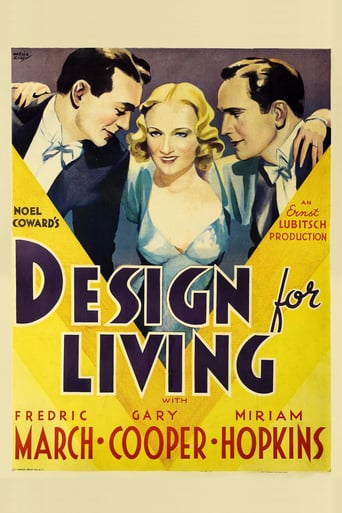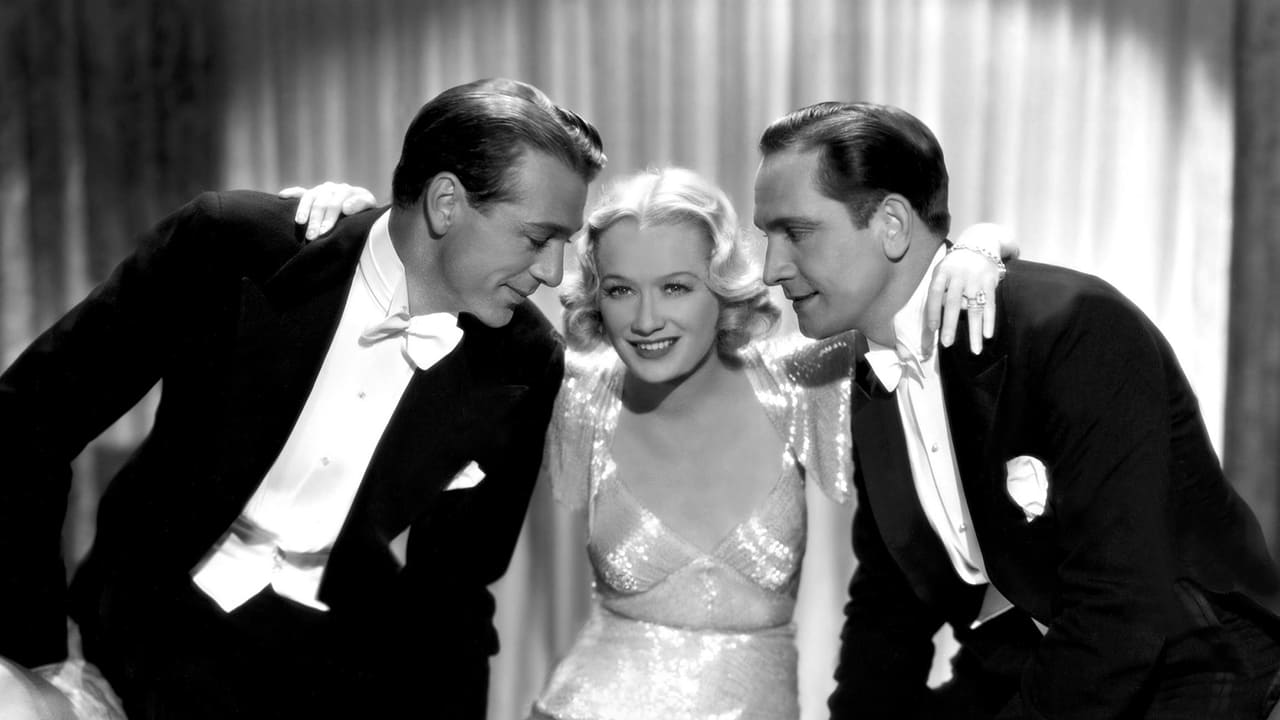lasttimeisaw
A minor Lubitsch fluff transposes Noël Coward's eponymous play onto the celluloid (but in only bare-bones terms), DESIGN FOR LIVING is a witty but stuffy comedy hammers out an uncharacteristic denouement for a risqué three-way relationship between two men and a woman, a progenitor of François Truffaut's JULES AND JIM (1962).Three Americans in Paris, best friends and roomies, struggling artists Tom Chambers (March) and George Curtis (Cooper) both are swept off their feet by a chic girl Gilda Farrell (Hopkins), who reciprocates them with isometric amount of affection, before soon a platonic ménage-à-trois under the same roof is propounded and accepted with a tripartite agreement, only sabotaged when one party is away in London for his burgeoning playwright career, the remaining two becomes an item, occasioning a crack in two men's friendship, and a seesawing Gilda has only one exit route when she is again, impelled to make the impossible choosing, leaving both and hurriedly marries to her long-time admirer Max Plunkett (Horton, utterly jolly in his priggish, business-oriented persona), which turns out to be an exasperating mistake on her part.
It is a jocose folie-à-trois panning out like a heady and mellifluous minuet, predominantly confined itself within interior spaces, aptly conceals its hanky-panky business off the screen (released within a whisker of the advent of the notorious Hays Code), but revels in its proto-screwball faux-naïf characterization to the hilt. The trio leads are all up for it, although acting side by side, a debonair March fairly eclipses an impetuous Cooper in his sonorous diction and unperturbed demeanor, but the cynosure here is a ripsnorting Hopkins, exerts her high-wire balancing act between two emblems of idealized American masculinity and only comically falls prey of her own indecision in the slapdash third act, as a matter of fact, Lubitsch cunningly expurgates all the frills and trimmings from his camera (including a climactic brawl, vanishingly completed in a trice), less is more, this blithe rom-com once again bears witness to Lubitsh's master-class aptitude of economic elegance under the Studio system.
blanche-2
For me, of course, there would be no choice. A young Gary Cooper - talk about a dream walking.Noel Coward's "Design for Living" was a play Coward wrote for himself and Lunt and Fontanne to star in, concerning a woman, Gilda, who can't decide between two young men and best friends in love with her, Tom and George. So the three decide to live together platonically. Tom leaves to work on his play, and while he's away, George and Gilda sleep together. Later on, alone with Tom, she sleeps with him, and George catches them together. Then Gilda makes a decision.Only one line from the original play was retained for the film. Though it is precode, the sex is inferred. Given the Lubitsch touch, it's a delightful, sexy comedy with pretty Miriam Hopkins as the winsome Gilda, Fredric March as Tom, a playwright, and Gary Cooper as George, an artist.The three young, attractive actors under Lubitsch's direction really make the film and situation sing.March was never much for comedy, though he does an okay job. Hopkins was a wonderful actress with many Broadway credits before getting into films, and Cooper was just so darned gorgeous I have no idea how he was except my impression is that he was very good. Had I been Hopkins - no choice! A charming film.
mark.waltz
Of Noel Coward's two drawing room sex comedies filmed during the 1930's, "Design For Living" seems the more sordid on celluloid. Along with "Private Lives", the play could not be filmed as written, and once Hollywood got their hands on the script, the red pen went on the attack.The story of "Design For Living" concerns three artists who meet on a train while traveling on the main European continent. Painter Gary Cooper and playwright Fredric March are pals whose car is suddenly invaded (much to their delight) by commercial artist Miriam Hopkins. Comically sketching the two sleeping men, Hopkins sets herself up for a memorable introduction to the two friends. They are soon cohabitating together, but each of the men is unaware of the other's interest in her. To prevent them from killing each other when all is revealed, Hopkins announces "no sex" and instead becomes their artistic sergeant, prodding them onto great success. Both men achieve popularity, but unable to choose between them, Hopkins marries her own Svengali, the sexless Edward Everett Horton. He can best be described as a non-threatening version of Clifton Webb's Waldo Lydecker in "Laura" to Hopkins' Gene Tierney.The flamboyantly gay Noel Coward doesn't stretch the imagination of his hidden signals in his play and the script can't hide it no matter how hard it tries. Even without Coward's racy dialogue, the premise is obvious that Hopkins' character could actually be male as well. Director Ernst Lubitsch puts together a beautifully art deco package that is sumptuous in every detail. It is his direction that shines here, not the performances of the two pretty boys or feisty leading lady. Horton is outstanding as Hopkins' Svengali, but it is disappointing not to see Horton interact here with fellow flibbertigibbet Franklin Pangborn who is barely on as London's top agent for playwrights. Nice cameos by two of Hollywood's best character performers (Jane Darwell and Mary Gordon) round out the cast.It is not surprising that this delicious looking comedy came from Paramount which produced even more art deco films in this era than MGM. Along with Lubitsch's "Trouble in Paradise" and Josef Von Sternberg's Marlene Dietrich series, this film remains one of the most famous, although an obscure drawing room comedy "Evenings For Sale" is also worth a look to add to that group.
lionel-libson-1
Lubitsch is always entertaining, and "Design For Living" is no exception. The casting is perfect, with Cooper establishing a comedic capability. The sets are threadbare but consistent with the zeitgeist of this variation on "La Boheme".Horton, as usual, is an ideal foil for the free spirits around him.I view this film as a "gay" adventure, using Miriam Hopkins as a woman in drag.Seen in this light, the sex in question takes on a different inference. Here, traditional marriage, children, etc., become irrelevant. The same could be said about "Breakfast at Tiffany's" or any of Joe Orton's plays.The script, Ben Hecht's rewrite of Noel Coward, occasionally slows to a wordy crawl, but a piece of comic action or verbal duelling saves the day.Near the end of the film, in a climactic argument between Hopkins and Horton, Gilda blurts what sounded to my timeworn ears like a classic expostulation. lacking a DVD to stop and replay, I'll leave it to the IMDb authorities to verify or refute. It was an entertaining enough film to get me to switch from the Yankee/Rangers game.


 AD
AD



